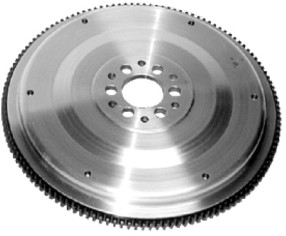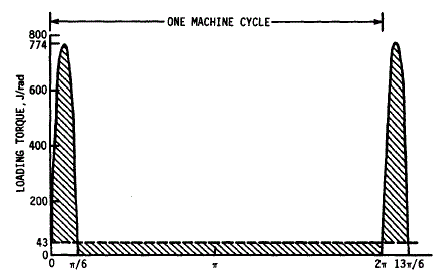Related Resources: mechanics machines
Flywheel Mass Size Design Equation and Calculator

Preview: Flywheel Mass, Size Design Calculator
The torque-angle relationship for an engine or machine depends on the the amount of work required. The large variation that is possible between different machine designs shows that dynamic measurement or kinematic analysis is necessary to determine the torque fluctuation. It is often necessary, however, to come up with a rough estimate for preliminary design purposes or for checking the reasonableness of calculated values. For these purposes, the energy variation for a machine or internal-combustion engine can be estimated by:
Energy equation variation flywheel
U = 0.5 J ( ω2max - ω2min )
Polar-mass moment of inertia Fly Wheel. This inertia includes the flywheel inertia and the inertia of all rotating parts, referred to the flywheel speed by multiplying by the square of the ratio of the shaft speeds.
J = U / ( ω2avg Cs )
Coefficient of Speed Variation of a Flywheel
Cs = ( ωmax - ωmin ) / ωavg
Suggested Design Values for the Coefficient of Speed Fluctuation Cs
| Required speed uniformity |
Cs
|
| Very uniform |
≤ 0.003
|
| Moderately uniform |
0.003-0.012
|
| Some variation acceptable |
0.012-0.05
|
| Moderate variation |
0.05-0.2
|
| Large variation acceptable |
≥ 0.2
|
The coefficient of energy variation Cu can be approximated for a two-stroke engine with from 1 to 8 cylinders using the equation:
Cu = 7.46 / ( Nc + 1 )3
Coefficient of energy variation for a four-stroke engine with from 1 to 16 cylinders using the two-branched equation:
Cu = 0.8 / ( Nc - 1.4 )1.3 - 0.015
Flywheel Weight:
W = J g / r2a
Cross Sectional Area of Flywheel:
A = J g / ( 2 π ρ r3a )
Power required :
P = T ω
Where:
J = Polar-mass moment of inertia, Ib · s2 · ft (N · s2 · m)
U = Energy Variation, difference between the flywheel energy at maximum speed and at minimum speed, Ib · ft (J)
Nc = Number of cylinders
Cu = Coefficient of energy variation
Cs = Uniformity Speed Constant
K = 33 000 lb · ft · rpm/hp
ω = Rotational speed, rad/s
ωavg = Average of ωmax and ωmin , rad/s
P = Power, hp (W)
g = Gravity 9.81 m/s2
D = Diameter m
ra = radius m
W = Mass kN
A = Cross sectional Area m2
ρ = Material Density kg/m3
T = Torque J ( 1 ft-lb = 1.355817948 J)

Typical Machine Power Cycle